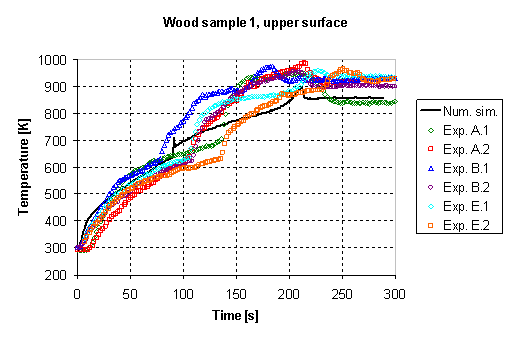A fire in a confined space can be divided into three distinct stages based on fuel
and oxygen consumption, heat release and variation of average gas temperature. These
stages are usually described as the fire growth period, fully developed fire and decay
period. Flashover is a short period of transition from a localized initial fire to
the fully developed fire where all fuel surfaces within the compartment start to burn.
From the fire-fighting perspective, flashover is a critical stage of fire growth. Namely,
when flashover takes place, the probability of survival of occupants rapidly decreases.
As the transition from the initial localized fire to the general conflagration takes
usually less than a minute, fatalities are very likely to occur. Also, flashover
creates a large increase in the rate of combustion; therefore, significantly greater
effort is needed to reduce the burning material below its ignition temperature.
Validation of flashover CFD model against experimental data

Flashover experimental setup [1]
A Computational Fluid Dynamics (CFD) model was developed to simulate flashover behaviour. It describes
transport of mass, momentum and energy in a gaseous environment. It also includes combustion and
thermal radiation. At the same time, degradation of wooden samples is described with a pyrolysis model.
To validate the numerical model, experimental results of Pearson et al. [1] were used. The figure above
shows their experimental setup.
The primary source of fire was a propane burner with thermal power of 55 kW. Square beech wood samples with the edge length of 30 mm and 5 mm thickness were used as fire spread targets. Exposed to the heat fluxes from the fire, the temperature in the wood samples rises; at some stage the wood undergoes pyrolysis. Time to ignition of the wooden samples and the sample temperature variations were used for comparison of the numerical and experimental results.
The primary source of fire was a propane burner with thermal power of 55 kW. Square beech wood samples with the edge length of 30 mm and 5 mm thickness were used as fire spread targets. Exposed to the heat fluxes from the fire, the temperature in the wood samples rises; at some stage the wood undergoes pyrolysis. Time to ignition of the wooden samples and the sample temperature variations were used for comparison of the numerical and experimental results.

First wood sample temperature comparison [2]
The developed numerical model allows simulation of fire spread and the subsequent flashover occurrence for
large scale fires with full geometrical complexity (i.e. potential fuel distribution and variety of
ventilation conditions) of a realistic residential environment.
References
- A. Pearson, J.-M. Most, Data on Flashover, Report, June 2006, CNRS, University of Poitiers, ENSMA, Laboratoire de Combustion et de Détonique, UPR 9028, Poitiers, France.
- A. Horvat, Y. Sinai, A. Pearson, J.-M. Most, Contribution to Flashover Modelling: Development of a Validated Numerical Model for Ignition of Non-Contiguous Wood Samples, Fire Safety J., 2009, Vol. 44, No. 5, pp. 779-788.
Dr Andrei Horvat
M.Sc. Mechanical Eng.
Ph.D. Nuclear Eng.
phone
+44 79 72 17 27 00
skype
a.horvat
e-mail
mail@caspus.co.uk
M.Sc. Mechanical Eng.
Ph.D. Nuclear Eng.
phone
+44 79 72 17 27 00
skype
a.horvat
mail@caspus.co.uk

